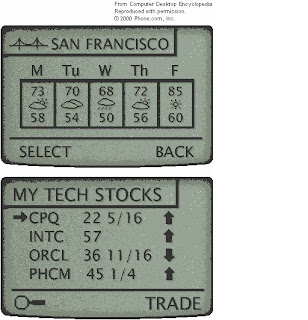(Wireless Application Protocol) A standard for providing cellular phones, pagers and other handheld devices with secure access to e-mail and text-based Web pages. Introduced in 1997 by Phone.com (later Openwave Systems), Ericsson, Motorola and Nokia, WAP provides a complete environment for wireless applications that includes a wireless counterpart of TCP/IP and a framework for telephony integration such as call control and phone book access.
WAP features the Wireless Markup Language (WML), which was derived from Phone.com's HDML and is a streamlined version of HTML for small screen displays. It also uses WMLScript, a compact JavaScript-like language that runs in limited memory. Supporting both keypad and voice recognition, WAP is independent of the air interface and runs over all major wireless networks. It is also device independent, requiring only a minimum functionality in the unit so that it can be used with a myriad of phones and handheld devices. See WTLS, OMA, HDML and i-Mode. See also wired access point.

Openwave Applications
Openwave has been the major contributor to the development of smartphone interfaces. Since there is precious little screen real estate, there is only room for straightforward and simple designs, which can provide a welcome relief from the massive information overload the Web normally delivers. (Image courtesy of Openwave Systems Inc.)

WAP features the Wireless Markup Language (WML), which was derived from Phone.com's HDML and is a streamlined version of HTML for small screen displays. It also uses WMLScript, a compact JavaScript-like language that runs in limited memory. Supporting both keypad and voice recognition, WAP is independent of the air interface and runs over all major wireless networks. It is also device independent, requiring only a minimum functionality in the unit so that it can be used with a myriad of phones and handheld devices. See WTLS, OMA, HDML and i-Mode. See also wired access point.

Openwave Applications
Openwave has been the major contributor to the development of smartphone interfaces. Since there is precious little screen real estate, there is only room for straightforward and simple designs, which can provide a welcome relief from the massive information overload the Web normally delivers. (Image courtesy of Openwave Systems Inc.)
